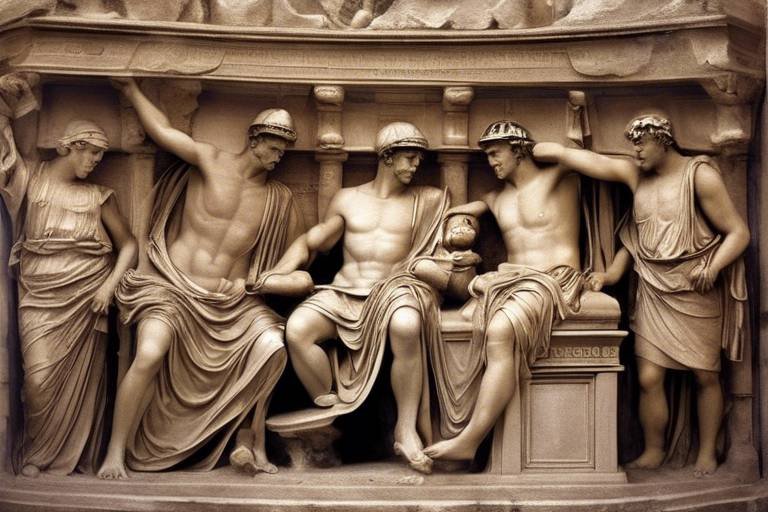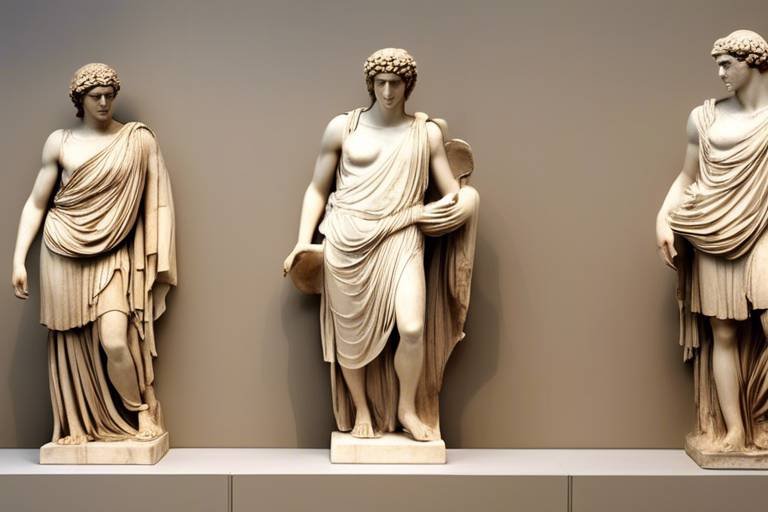The Legacy of the Impressionist Movement
The Legacy of the Impressionist Movement holds a profound influence on the world of art, leaving an indelible mark on artistic expression. Originating in 19th-century France, Impressionism marked a departure from traditional artistic techniques, embracing a new way of capturing the essence of fleeting moments through light and color. This revolutionary movement introduced a fresh perspective that continues to inspire artists and art enthusiasts globally.

Origins of Impressionism
Impressionism, a revolutionary art movement that emerged in 19th-century France, marked a significant departure from traditional artistic techniques. The Impressionists sought to capture the fleeting moments of everyday life with an emphasis on light, color, and atmosphere.
The Impressionist movement originated in the mid-1800s in France, led by a group of avant-garde artists who rebelled against the strict conventions of the art establishment. Artists like Claude Monet, Edgar Degas, and Pierre-Auguste Renoir were at the forefront, challenging the norms of academic painting.
These artists were inspired by the changing world around them, seeking to portray the effects of light and movement in their works. Their innovative approach to painting, characterized by loose brushwork and a focus on capturing the essence of a moment, laid the foundation for Impressionism.
The term "Impressionism" was coined from Monet's painting "Impression, Sunrise," which was exhibited in 1874 and sparked both admiration and controversy. Critics initially ridiculed the loose, unfinished style of the Impressionists, but over time, their work gained recognition and appreciation.

Influential Impressionist Artists
Impressionism, a revolutionary art movement that emerged in 19th-century France, marked a significant departure from traditional artistic techniques. The artists associated with this movement sought to capture the essence of a moment through their unique interpretation of light, color, and form.
Among the key figures who played a pivotal role in shaping the Impressionist style were Claude Monet, Edgar Degas, and Pierre-Auguste Renoir. Each artist brought their own perspective and artistic flair to the movement, contributing to its diverse and vibrant character.

Characteristics of Impressionist Art
Impressionism, a revolutionary art movement that emerged in 19th-century France, marked a significant departure from traditional artistic conventions. The Impressionists, with their innovative approach to capturing light, color, and fleeting moments, created a lasting impact on the art world.
Impressionist art is characterized by its unique features that set it apart from traditional styles. One of the key aspects of Impressionism is its emphasis on capturing the essence of a scene rather than focusing on intricate details. Artists like Claude Monet, Edgar Degas, and Pierre-Auguste Renoir utilized loose brushwork and vibrant colors to convey the changing effects of light and atmosphere.
Furthermore, Impressionist paintings often depict everyday scenes and landscapes, showcasing the beauty found in ordinary moments. The artists sought to capture the immediacy and transience of their subjects, giving viewers a sense of being present in that specific moment in time.
The use of visible brushstrokes and the absence of strict outlines in Impressionist works contribute to the sense of movement and spontaneity, inviting the viewer to engage with the artwork on a more emotional level. This departure from the precise realism of academic art at the time was both groundbreaking and controversial.
Moreover, Impressionist artists frequently painted en plein air, or outdoors, to directly observe and capture the effects of natural light on their subjects. This practice allowed them to infuse their paintings with a sense of vitality and immediacy, creating dynamic compositions that reflected the beauty of the natural world.
In essence, the characteristics of Impressionist art revolve around a fresh perspective on light, color, and the fleeting moments of everyday life, challenging traditional artistic norms and inspiring generations of artists to come.
1. What inspired the Impressionist artists to break away from traditional painting techniques?
2. How did the public and critics initially react to Impressionist art?
3. What role did exhibitions like the Salon des Refusés play in the promotion of Impressionism?
4. How did Impressionism influence later art movements such as Post-Impressionism and Modernism?
5. What are some famous Impressionist paintings that have left a lasting impact on the art world?

Impact on Artistic Techniques
Impressionism, with its revolutionary approach to art, had a profound impact on artistic techniques that reverberates through the art world to this day. By prioritizing the expression of light and color over precise details, Impressionist artists introduced a new way of seeing and depicting the world around them. This departure from traditional academic painting techniques marked a significant shift in the art world, challenging artists to explore innovative methods of capturing the essence of a scene.
One of the key contributions of Impressionism to artistic techniques was the emphasis on plein air painting, or painting outdoors. This practice allowed artists to capture the effects of natural light on their subjects in real-time, resulting in paintings that were vibrant and dynamic. The use of broken brushwork and unblended colors also became hallmarks of Impressionist art, giving their works a sense of movement and immediacy.
The Impressionist focus on capturing fleeting moments and impressionistic interpretations of reality challenged the conventions of the time, encouraging artists to experiment with new techniques and ways of seeing. This departure from academic traditions paved the way for modern art movements that valued individual expression and subjective interpretations of the world.

Reception and Criticism
Impressionism, a revolutionary art movement that emerged in 19th-century France, holds a significant place in the history of art. The movement marked a departure from traditional artistic techniques, embracing new approaches to capturing light, color, and fleeting moments.
When Impressionism first burst onto the art scene, it faced harsh criticism from traditional art critics and the public. The loose brushwork and unconventional compositions of Impressionist paintings challenged the established norms of the time, leading many to question the legitimacy of this new artistic style. Critics often derided Impressionist works as unfinished or amateurish, failing to appreciate the innovative approach to capturing the essence of a scene.
However, as time passed, the tide began to turn, and the Impressionist movement gained recognition for its bold experimentation and unique perspective. Artists such as Claude Monet, Edgar Degas, and Pierre-Auguste Renoir, once scorned by critics, started to be celebrated for their contributions to the art world. The public's perception also shifted, with more and more art enthusiasts appreciating the vibrancy and emotion conveyed through Impressionist paintings.
Despite the initial backlash, Impressionism eventually found its place in the art world, influencing future generations of artists and paving the way for modern art movements. The movement's ability to capture the fleeting beauty of everyday life and the play of light on different surfaces resonated with audiences, transcending the boundaries of traditional artistic expression.

Global Influence of Impressionism
Impressionism, a revolutionary art movement that emerged in 19th-century France, holds a significant place in the history of art. Its departure from traditional techniques marked a turning point in artistic expression, setting the stage for modern art movements to come.
The impact of Impressionism transcended borders, spreading its influence far beyond the shores of France. Artists around the world were captivated by the innovative approach of Impressionist painters, leading to the integration of its principles into diverse artistic traditions.
One of the key aspects of Impressionism that resonated globally was its focus on capturing fleeting moments and ephemeral impressions. This emphasis on the transient nature of light and color appealed to artists seeking to break free from rigid academic conventions and explore new realms of artistic expression.
Claude Monet, with his iconic water lilies and landscapes, inspired painters in Japan, the United States, and beyond to experiment with light and color in their own works. The influence of Edgar Degas's dynamic compositions and Pierre-Auguste Renoir's vibrant scenes of everyday life reached artists in Europe and beyond, shaping the course of art history.
The global reach of Impressionism can be seen in the diverse interpretations and adaptations of its principles in different cultural contexts. From the delicate cherry blossoms of Japanese Impressionism to the bold brushwork of American Impressionist painters, the movement's legacy continues to inspire artists worldwide.
Q: What are the key characteristics of Impressionist art?
A: Impressionist art is known for its emphasis on light, color, and capturing fleeting moments. Artists often used visible brushstrokes and a vibrant palette to convey the essence of a scene rather than focusing on detailed realism.
Q: How did Impressionism influence modern art movements?
A: Impressionism revolutionized artistic practices by challenging traditional techniques and conventions. It paved the way for movements such as Post-Impressionism, Fauvism, and Cubism, which further pushed the boundaries of artistic expression.
Q: What efforts are being made to preserve Impressionist works?
A: Museums and conservation organizations worldwide are dedicated to conserving and protecting Impressionist masterpieces for future generations. Through careful restoration and preservation techniques, these works are safeguarded for continued appreciation.

Legacy in Contemporary Art
Impressionism, a revolutionary art movement that emerged in 19th-century France, holds a significant place in the history of art. The movement marked a departure from traditional artistic techniques, embracing a new way of capturing the essence of a scene rather than focusing on precise details.
The legacy of Impressionism in contemporary art is profound and enduring. The Impressionist style continues to influence artists around the world, shaping modern art trends and artistic expression. The emphasis on capturing light, color, and fleeting moments remains a cornerstone of many contemporary artworks, reflecting the enduring appeal and relevance of Impressionism.

Preservation of Impressionist Works
Preserving Impressionist works is crucial to safeguarding these valuable pieces of art for future generations. Museums, art institutions, and conservationists around the world dedicate significant resources to ensure the longevity of these masterpieces. Conservation efforts involve meticulous care, restoration, and protection of the delicate paintings created by renowned Impressionist artists.
Conservationists employ specialized techniques to prevent deterioration and damage to Impressionist works. Factors such as light exposure, humidity levels, and environmental pollutants can pose significant threats to the integrity of these paintings. Through controlled storage conditions and regular maintenance, conservators strive to maintain the vibrancy and authenticity of the original artworks.
Restoration processes play a vital role in preserving Impressionist works, addressing issues such as discoloration, surface damage, and aging effects. Skilled conservators delicately clean, repair, and stabilize paintings to ensure they retain their aesthetic appeal and historical significance. By employing advanced conservation methods, experts aim to extend the lifespan of Impressionist masterpieces for future appreciation.
Collaboration between art institutions, conservation labs, and experts in the field is essential for effective preservation of Impressionist works. Through research, analysis, and documentation, professionals work together to develop comprehensive conservation strategies tailored to the specific needs of each artwork. This collaborative approach ensures that best practices are implemented to safeguard these cultural treasures.
Efforts to preserve Impressionist works also involve raising awareness about the importance of art conservation and the significance of these iconic paintings. Educational programs, public exhibitions, and outreach initiatives aim to engage audiences in understanding the value of preserving cultural heritage. By fostering appreciation for Impressionist art and conservation practices, the legacy of these influential works can be upheld for generations to come.

Continued Inspiration from Impressionism
Impressionism, with its revolutionary approach to capturing light and fleeting moments, continues to be a wellspring of inspiration for contemporary artists. The ethos of spontaneity and the emphasis on capturing the essence rather than the details have transcended time, influencing a myriad of artistic expressions across various mediums.
Modern artists draw upon the Impressionist philosophy to infuse their works with a sense of vitality and immediacy. By embracing the Impressionist emphasis on color and light, artists create pieces that evoke emotions and transport viewers to different worlds, much like the Impressionist masters did in their time.
The legacy of Impressionism can be seen in the vibrant palettes and dynamic brushwork of many contemporary artworks. Artists experiment with light and shadow, seeking to convey the essence of a moment rather than a literal representation. This approach adds depth and emotion to their creations, inviting viewers to engage with the artwork on a visceral level.
Moreover, the influence of Impressionism extends beyond traditional painting to other art forms such as photography, sculpture, and even digital art. The principles of capturing fleeting moments and exploring the interplay of light and color have inspired artists working in diverse mediums, showcasing the enduring relevance of Impressionism in the modern art landscape.
Contemporary artists continue to push the boundaries of artistic expression, drawing inspiration from the Impressionist movement's innovative spirit. By embracing the spontaneity and freedom championed by Impressionist artists, today's creators forge new paths in the art world, honoring the legacy of those who dared to challenge conventions and redefine the boundaries of artistic expression.
Frequently Asked Questions
- What is Impressionism?
Impressionism was an art movement that emerged in the 19th century, characterized by its focus on capturing the transient effects of light and color. Artists of this movement aimed to depict scenes in a more naturalistic and spontaneous manner, breaking away from the rigid conventions of traditional art.
- Who were some notable Impressionist artists?
Key figures in the Impressionist movement include Claude Monet, known for his iconic water lilies and landscapes, Edgar Degas, renowned for his ballet dancers and horse racing scenes, and Pierre-Auguste Renoir, celebrated for his vibrant portraits and everyday life depictions.
- What are the main characteristics of Impressionist art?
Impressionist art is characterized by its emphasis on capturing the effects of light and color, use of visible brushstrokes, depiction of everyday scenes, and focus on portraying fleeting moments and atmospheric conditions.
- How did Impressionism influence modern art?
Impressionism revolutionized artistic techniques by challenging traditional methods and paved the way for modern art movements such as Post-Impressionism, Fauvism, and Cubism. Its innovative approach to color, light, and composition had a profound impact on the art world.
- What is the global influence of Impressionism?
Impressionism transcended borders and had a significant impact on artists worldwide, inspiring new artistic approaches and styles in various countries. Its influence can be seen in the works of artists beyond France, shaping diverse art movements across the globe.
- How does Impressionism continue to inspire contemporary artists?
The spirit of Impressionism continues to inspire contemporary artists by encouraging them to explore light, color, and subjective interpretations of reality. Its legacy lives on in the diverse artistic expressions of today, influencing ongoing trends in the art world.



















